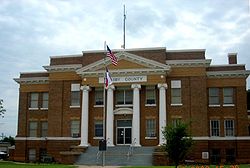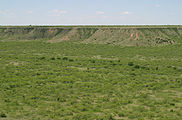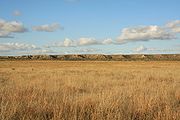- Crosby County, Texas
-
Crosby County, Texas Crosby County Courthouse in Crosbyton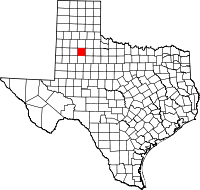
Location in the state of Texas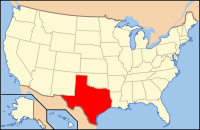
Texas's location in the U.S.Founded 1876 Seat Crosbyton Area
- Total
- Land
- Water
902 sq mi (2,336 km²)
900 sq mi (2,331 km²)
2 sq mi (5 km²), 0.24%Population
- (2000)
- Density
7,072
8/sq mi (3/km²)Website www.co.crosby.tx.us Crosby County is a county located in the U.S. state of Texas. In 2000, its population was 7,072. The seat of the county is Crosbyton[1]. The county and its seat are both named for Stephen Crosby, a land commissioner in Texas. Crosby County is one of 30[2] prohibition, or entirely dry, counties in the state of Texas. It forms part of the Lubbock metropolitan area. Crosby County was founded in 1876.
Part of the large Matador Ranch of West Texas extends into Crosby County.[3]
Contents
History timeline
- 11000 b.c. Paleo-Indians first inhabitants. Archeological artifacts indicate Hunter-gatherers who hunted the Mammoth, Mastodon, Saber-Toothed Tiger, and Giant Ground Sloth. Later native American inhabitants include the Comanche.[4]
- 1871 Ranald S. Mackenzie fights Quanah Parker and other Comanches at the Battle of Blanco Canyon. The campaign establishes the Mackenzie Trail used by the first settlers in Crosby County in the late 1870s.[5]
- 1876 The Texas legislature forms Crosby County from Young and Bexar districts.[4]
- 1878 Bavaria-born Heinrich Schmidtt, aka Henry “Hank” Clay Smith, and his wife Elizabeth Boyle and their six children, become the first permanent settlers in the area, where Hank is active in the county’s organization.[6][7][8]
- 1879 Confederate veteran Paris Cox first visits the Caprock Escarpment of the Llano Estacado with a group of buffalo hunters.[9]
- 1886 Estacado is named the county seat.[10]
- 1900 The beef industry thrives, supporting a count of 30,618 head.[4]
- 1908 The Bar-N-Bar Ranch begins selling acreage to farmers.[4]
- 1910 Crosbyton becomes the new county seat.[11]
- 1920 Some 45,400 acres (184 km2) in the county are planted in cotton. 15.000 apple and peach trees grow in the county.[4]
- 1929 Farmers own 83,000 chickens, and sell 395,000 dozen eggs.[4]
- 1941 The first soil-conservation district in the county is formed.[4]
- 1955 Oil is discovered in the county.[4]
Geography
According to the U.S. Census Bureau, the county has a total area of 902 square miles (2,336.2 km2), of which 900 square miles (2,331.0 km2) is land and 2 square miles (5.2 km2) (0.24%) is water.
Major highways
Adjacent counties
- Floyd County (north)
- Dickens County (east)
- Garza County (south)
- Lubbock County (west)
Geographic features
- Blanco Canyon
- White River, Silver Falls
- Mount Blanco
- Caprock Escarpment
-
Caprock Escarpment south of Ralls
Demographics
As of the census[12] of 2000, there were 7,072 people, 2,512 households, and 1,866 families residing in the county. The population density was 8 people per square mile (3/km²). There were 3,202 housing units at an average density of 4 per square mile (1/km²). The racial makeup of the county was 63.77% White, 3.89% Black or African American, 0.54% Native American, 0.03% Asian, 0.07% Pacific Islander, 29.89% from other races, and 1.81% from two or more races. 48.93% of the population were Hispanic or Latino of any race.
There were 2,512 households out of which 35.6% had children under the age of 18 living with them, 59.0% were married couples living together, 11.4% had a female householder with no husband present, and 25.7% were non-families. 23.8% of all households were made up of individuals and 13.4% had someone living alone who was 65 years of age or older. The average household size was 2.78 and the average family size was 3.30.
In the county, the population was spread out with 30.7% under the age of 18, 8.5% from 18 to 24, 24.0% from 25 to 44, 21.1% from 45 to 64, and 15.6% who were 65 years of age or older. The median age was 34 years. For every 100 females there were 91.1 males. For every 100 females age 18 and over, there were 87.2 males.
The median income for a household in the county was $25,769, and the median income for a family was $29,891. Males had a median income of $23,775 versus $17,229 for females. The per capita income for the county was $14,445. About 22.6% of families and 28.1% of the population were below the poverty line, including 36.6% of those under age 18 and 22.7% of those age 65 or over.
Cities
Other places
- Cone
- Estacado
- Kalgary
See also
- Blanco Canyon
- Dry counties
- Llano Estacado
- Mount Blanco
- National Register of Historic Places listings in Crosby County, Texas
- White River (Texas)
- Yellow House Canyon
References
- ^ "Find a County". National Association of Counties. http://www.naco.org/Counties/Pages/FindACounty.aspx. Retrieved 2011-06-07.
- ^ "Wet/Dry Status of Texas Counties as of November 2010". Texas Alcoholic Beverage Commission. http://www.tabc.state.tx.us/images/wetdry.gif. Retrieved 16 December 2010.
- ^ "Alyssa Dizon, "Cattle raisers honor Matador Ranch with rangeland management award"". Lubbock Avalanche-Journal, April 4, 2011. http://lubbockonline.com/interact/blog-post/alyssa-dizon/2011-04-04/cattle-raisers-honor-matador-ranch-rangeland-management. Retrieved April 29, 2011.
- ^ a b c d e f g h Leffler, John. "Crosby County, Texas". Handbook of Texas Online. Texas State Historical Association. http://www.tshaonline.org/handbook/online/articles/hcc27. Retrieved 16 December 2010.
- ^ Gwynne, S. C. (2010). Empire of the Summer Moon: Quanah Parker and the Rise and Fall of the Comanches, the Most Powerful Indian Tribe in American History. Scribner. pp. 10, 11. ISBN 978-1416591054.
- ^ Rodenberger, Lou Halsell; Butler, Laura Payne;Kolosoy, Jacqueline (2005). "Elizabeth Boyle (Aunt Hank) Smith". Writing On The Wind: An Anthology Of West Texas Women Writers. Texas Tech University Press. p. 174. ISBN 978-0896725485.
- ^ "Smith, Henry Clay (1836-1912) - Crosbyton, Crosby County, Texas". Texas Historical Markers. William Nienke, Sam Morrow. http://www.9key.com/markers/marker_detail.asp?atlas_number=5107002477. Retrieved 16 December 2010.
- ^ Pearce, William M. "Henry Clay Smith". Handbook of Texas Online. Texas State Historical Association. http://www.tshaonline.org/handbook/online/articles/fsm24. Retrieved 16 December 2010.
- ^ Lively, Jeanne F. "Paris Cox". Handbook of Texas Online. Texas State Historical Association. http://www.tshaonline.org/handbook/online/articles/fco86. Retrieved 16 December 2010.
- ^ "Estacado, Texas". Texas Escapes. Texas Escapes - Blueprints For Travel, LLC. http://www.texasescapes.com/TexasTowns/Estacado-Texas.htm. Retrieved 16 December 2010.
- ^ "Crosbyton, Texas". Texas Escapes. Texas Escapes - Blueprints For Travel, LLC. http://www.texasescapes.com/TexasPanhandleTowns/CrosbytonTexas.htm. Retrieved 16 December 2010.
- ^ "American FactFinder". United States Census Bureau. http://factfinder.census.gov. Retrieved 2008-01-31.
External links
- Panhandle-Plains Historical Museum
- Crosby County government’s website
- Crosby County in Handbook of Texas Online

Floyd County 
Lubbock County 
Dickens County  Crosby County, Texas
Crosby County, Texas 

Garza County Municipalities and communities of Crosby County, Texas Cities Unincorporated
communitiesCone | Kalgary
Ghost town Estacado
Categories:- Texas counties
- Crosby County, Texas
- 1876 establishments in the United States
- Populated places established in 1876
Wikimedia Foundation. 2010.

